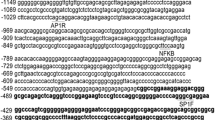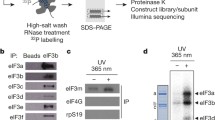Abstract
Through its transcriptional activities, the proto-oncoprotein c-jun can regulate cellular proliferation, survival, and differentiation. We have established a novel yeast assay that screens for repressors of c-jun transcriptional activity. This screen led to the identification of a ubiquitously expressed novel RING zinc finger protein, termed Makorin RING zinc finger protein 1 (MKRN1), recently shown to act as an E3 ubiquitin ligase. Overexpression of MKRN1 in mammalian cells inhibited the transcriptional activities of not only c-jun, but also the nuclear receptors, the androgen receptor, and the retinoic acid receptors. Truncation analysis indicates that both the amino and carboxy termini are required for this transrepression activity. Surprisingly, when fused to the heterologous DNA-binding domain of GAL4, MKRN1 activates, rather than inhibits, a GAL4-responsive reporter plasmid. In addition, truncation of either the amino- or carboxy-terminal half of MKRN1 disrupts its transactivation activity, the same observation that was made on its transrepression activity. These results demonstrate that MKRN1 has transcriptional activity and suggest that its transrepression and transactivation functions are mediated by the same mechanism. Interestingly, disruption of MKRN1's ubiquitin ligase activity does not affect its inhibitory transcriptional activity. Thus, MKRN1 may represent a nuclear protein with multiple nuclear functions, including regulating RNA polymerase II-catalyzed transcription.
Similar content being viewed by others
References
Karin, M., Liu, Z., and Zandi, E. (1997). Curr. Opin. Cell Biol. 9, 240–246.
Hartl, M., Bader, A. G., and Bister, K. (2003). Curr. Cancer Drug Targets 3, 41–55.
Chinenov, Y. and Kerppola, T. K. (2001). Oncogene 20, 2438–2352.
Dunn, C., Wiltshire, C., MacLaren, A., and Gillespie, D. A. F. (2002). Cell. Signal. 14, 585–593.
Vlaeminck-Guillem, V., Laudet, V., and Duterque-Coquillaud, M. (2003). Med. Sci. 19, 1121–1127.
Miner, J. N., Diamond, M. I., and Yamamoto, K. R. (1991). Cell. Growth Differ. 2, 525–530.
Nakae, K., Nakajima, K., Inazawa, J., Kitaoka, T., and Hirano, T. (1995). J. Biol. Chem. 270, 23795–23800.
Behre, G., Whitmarsh, A. J., Coghlan, M. P., et al. (1999). J. Biol. Chem. 274, 4939–4946.
Wise, S. C., Burmeister, L. A., Zhou, X.-F., et al. (1998). Oncogene 16, 2001–2009.
van Dam, H., Huguier, S., Kooistra, K., et al. (1998). Genes Dev. 12, 1227–1239.
Venugopal, R. and Jaiswal, A. K. (1998). Oncogene 17, 3145–3156.
Kerppola, T. K. and Curran, T. (1994). Oncogene 9, 3149–3158.
Pearce, D. and Yamamoto, K. R. (1993). Science 259, 1161–1165.
Peterson, B. R., Sun, L. J., and Verdine, G. L. (1996). Proc. Natl. Acad. Sci. USA 93, 13671–13676.
Bassuk, A. G. and Leiden, J. M. (1995). Immunity 3, 223–237.
Zhang, Y., Feng, X. H., and Derynck, R. (1998). Nature 394, 909–913.
Zhang, X., Wrzeszczynska, M. H., Horvath, C. M., and Darnell, J. E. (1999). Mol. Cell. Biol. 19, 7138–7146.
Li, L., Chambard, J. C., Karin, M., and Olson, E. N. (1992) Genes Dev. 6, 676–689.
Martin, M. L., Lieberman, P. M., and Curran, T. (1996). Mol. Cell. Biol. 16, 2110–2118.
Claret, F. X., Hibi, M., Dhut, S., Toda, T., and Karin, M. (1996). Nature 383, 453–457.
Chen, L. C., Chen, B. K., Chang, J. M., and Chang, W. C. (2004). Biochim. Biophys. Acta 1683, 38–48.
Lee, S. K., Kim, H. J., Na, S. Y., et al. (1998). J. Biol. Chem. 273, 16651–16654.
Piu, F., Aronheim, A., Katz, S., and Karin, M. (2001). Mol. Cell. Biol. 21, 3012–3024.
Ogawa, S., Lozach, J., Jepsen, K., et al. (2004). Proc. Natl. Acad. Sci. USA 101, 14461–14466.
Shemshedini, L., Knauthe, R., Sassone-Corsi, P., Pornon, A., and Gronemeyer, H. (1992). EMBO J. 10, 3839–3849.
Bubulya, A., Wise, S. C., Shen, X.-Q., Burmeister, L. A., and Shemshedini, L. (1996). J. Biol. Chem. 271, 24583–24589.
Tillman, K., Oberfield, J. J., Shen, X.-Q., Bubulya, A., and Shemshedini, L. (1998). Endocrine 9, 193–200.
Gray, T. A., Hernandez, L., Carey, A. H., et al. (2000). Genomics 66, 76–86.
Kim, J. H., Park, S. M., Kang, M. R., et al. (2005). Genes Dev. 19, 776–781.
Howell, B. W., Afar, D. E., Lew, J., et al. (1991)., Mol. Cell. Biol. 11, 568–572.
Zhou, X. F., Shen, X. Q., and Shemshedini, L. (1999). Mol. Endocrinol. 13, 276–285.
Horlein, A. J., Naar, A. M., Heinzel, T., et al. (1995). Nature 377, 397–404.
Chen, J. D. and Evans, R. M. (1995). Nature 377, 454–457.
Matthews, J. M. and Sunde, M. (2002). IUBMB Life 54, 351–355.
Klug, A. and Schwabe, J. W. (1995). FASEB J. 9, 597–604.
Borden, K. L. (2000). J. Mol. Biol. 295, 1103–1012.
Joazeiro, C. A. and Weissman, A. M. (2000). Cell 102, 549–552.
Cairns, C. A. and White, R. J. (1998). EMBO J. 17, 3112–3123.
Xu, L., Glass, C. K., and Rosenfeld, M. G. (1999). Curr. Opin. Genet. Dev. 9, 140–147.
Marmorstein, R., Carey, M., Ptashne, M., and Harrison, S. C. (1992). Nature 356, 408–414.
Marmostein, R. and Harrison, S. C. (1994). Genes Dev. 8, 2504–2512.
Bubulya, A., Chen, S. Y., Fisher, C. J., Zheng, Z., Zhou, X. F., Shen, X. Q., and Shemshedini, L. (2001). J. Biol. Chem. 276, 44704–44711.
Langley, E., Kemppainen, J. A., and Wilson, E. M. (1998). J. Biol. Chem. 273, 92–101.
Chene, P. (2001). Oncogene 20, 2611–2617.
Hirotsune, S., Yoshida, N., Chen, A., et al. (2003). Nature 423, 91–96.
Shenk, J. L., Fisher, C. J., Chen, S. Y., Zhou, X. F., Tillman, K., and Shemshedini, L. (2001). J. Biol. Chem. 276, 38472–38479.
Cheshire, J. L. and Baldwin, A. S. Jr. (1997). Mol. Cell. Biol. 17, 6746–6754.
Shen, X. Q., Bubulya, A., Zhou, X. F., Khazak, V., Golemis, E. A., and Shemshedini, L. (1999). Endocrine 10, 281–289.
Gyuris, J., Golemis, E., Chertkov H., and Brent, R. (1993) Cell 75, 791–803.
Ausubel, F. M., Brent, R., Kingston, R. E., et al., (1998). Current protocols in molecular biology. vol. 2. Wiley, New York.
Author information
Authors and Affiliations
Corresponding author
Rights and permissions
About this article
Cite this article
Omwancha, J., Zhou, XF., Chen, SY. et al. Makorin RING finger protein 1 (MKRN1) has negative and positive effects on RNA polymerase II-dependent transcription. Endocr 29, 363–373 (2006). https://doi.org/10.1385/ENDO:29:2:363
Received:
Revised:
Accepted:
Issue Date:
DOI: https://doi.org/10.1385/ENDO:29:2:363




